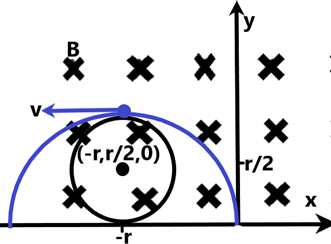
A particle of positive charge q and mass m enters with velocity \[v\widehat{j}\] at the origin in a magnetic field \[B(-\overset\frown{k})\] which is present in the whole space. The charge makes a perfectly inelastic collision with an identical particle (having same charge) at rest but free to move at its maximum positive y-coordinate. After collision, the combined charge will move on trajectory (where \[r=\dfrac{mv}{qB}\]) –
\[\begin{align}
& \text{A) }y=\dfrac{mv}{qB}x \\
& \text{B) (}x+r{{)}^{2}}+{{(y-\dfrac{r}{2})}^{2}}=\dfrac{{{r}^{2}}}{4} \\
& \text{C) (}x+r{{)}^{2}}+{{(y-\dfrac{r}{2})}^{2}}=\dfrac{{{r}^{2}}}{8} \\
& \text{D) (}x-r{{)}^{2}}+{{(y+\dfrac{r}{2})}^{2}}=\dfrac{{{r}^{2}}}{4} \\
\end{align}\]
Answer
555.3k+ views
Hint: We need to understand the situation when a body inelastically collides with another body, here the charge in particular and the effect of the charges being in a magnetic field with a velocity imparted due to momentum to solve this problem.
Complete Solution:
We know that the inelastic collisions are a result of the sticking of the colliding particles without causing any complete transfer of the kinetic energy into the second body. The momentum after the collision is as a result of the cumulative mass of the two charges, which can be given as –
\[\begin{align}
& \text{Momemtum before collision = Momentum after collision} \\
& \Rightarrow mv+0=(m+m){{v}_{f}} \\
& \therefore {{v}_{f}}=\dfrac{v}{2} \\
\end{align}\]
Now, we are told that the charge was initially moving with a velocity ‘v’ along the y-direction in a perpendicular magnetic field. We know that the Lorentz force acting on the particle will result in a circular path with a radius that can be given as –
\[{{r}_{before}}=\dfrac{mv}{qB}\]
The two charges after sticking together can be given as –
\[\begin{align}
& {{r}_{after}}=\dfrac{2m{{v}_{f}}}{2qB} \\
& \Rightarrow {{r}_{after}}=\dfrac{2m\dfrac{v}{2}}{2qB} \\
& \therefore {{r}_{after}}=\dfrac{{{r}_{before}}}{2} \\
\end{align}\]

So, using the equation of a circle, we can find the final trajectory of the two charges as –
\[\begin{align}
& {{x}^{2}}+{{y}^{2}}={{r}^{2}} \\
& \Rightarrow {{(x+r)}^{2}}+{{(y-\dfrac{r}{2})}^{2}}={{(\dfrac{r}{2})}^{2}} \\
& \therefore {{(x+r)}^{2}}+{{(y-\dfrac{r}{2})}^{2}}=\dfrac{{{r}^{2}}}{4} \\
\end{align}\]
This is the required trajectory for the system of charges in the given magnetic field.
Hence, the correct answer is option B.
Note:
We are told in the question that the two particles are free to move in the y-direction, but not in other directions. This is why we haven’t considered the change in the radius of circular motion along the x-direction for the final equation of the trajectory.
Complete Solution:
We know that the inelastic collisions are a result of the sticking of the colliding particles without causing any complete transfer of the kinetic energy into the second body. The momentum after the collision is as a result of the cumulative mass of the two charges, which can be given as –
\[\begin{align}
& \text{Momemtum before collision = Momentum after collision} \\
& \Rightarrow mv+0=(m+m){{v}_{f}} \\
& \therefore {{v}_{f}}=\dfrac{v}{2} \\
\end{align}\]
Now, we are told that the charge was initially moving with a velocity ‘v’ along the y-direction in a perpendicular magnetic field. We know that the Lorentz force acting on the particle will result in a circular path with a radius that can be given as –
\[{{r}_{before}}=\dfrac{mv}{qB}\]
The two charges after sticking together can be given as –
\[\begin{align}
& {{r}_{after}}=\dfrac{2m{{v}_{f}}}{2qB} \\
& \Rightarrow {{r}_{after}}=\dfrac{2m\dfrac{v}{2}}{2qB} \\
& \therefore {{r}_{after}}=\dfrac{{{r}_{before}}}{2} \\
\end{align}\]

So, using the equation of a circle, we can find the final trajectory of the two charges as –
\[\begin{align}
& {{x}^{2}}+{{y}^{2}}={{r}^{2}} \\
& \Rightarrow {{(x+r)}^{2}}+{{(y-\dfrac{r}{2})}^{2}}={{(\dfrac{r}{2})}^{2}} \\
& \therefore {{(x+r)}^{2}}+{{(y-\dfrac{r}{2})}^{2}}=\dfrac{{{r}^{2}}}{4} \\
\end{align}\]
This is the required trajectory for the system of charges in the given magnetic field.
Hence, the correct answer is option B.
Note:
We are told in the question that the two particles are free to move in the y-direction, but not in other directions. This is why we haven’t considered the change in the radius of circular motion along the x-direction for the final equation of the trajectory.
Recently Updated Pages
A man running at a speed 5 ms is viewed in the side class 12 physics CBSE

State and explain Hardy Weinbergs Principle class 12 biology CBSE

Which of the following statements is wrong a Amnion class 12 biology CBSE

Two Planoconcave lenses 1 and 2 of glass of refractive class 12 physics CBSE

The compound 2 methyl 2 butene on reaction with NaIO4 class 12 chemistry CBSE

Bacterial cell wall is made up of A Cellulose B Hemicellulose class 12 biology CBSE

Trending doubts
What are the major means of transport Explain each class 12 social science CBSE

Which are the Top 10 Largest Countries of the World?

Draw a labelled sketch of the human eye class 12 physics CBSE

Explain sex determination in humans with line diag class 12 biology CBSE

The pH of the pancreatic juice is A 64 B 86 C 120 D class 12 biology CBSE

Give 10 examples of unisexual and bisexual flowers




